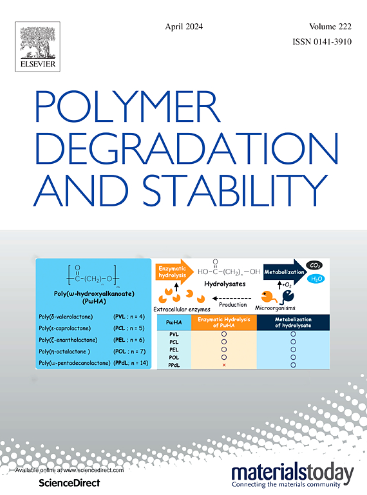Development of a DOPO-based flame retardant with pendant chains for enhanced polyurethane elastomers
IF 6.3
2区 化学
Q1 POLYMER SCIENCE
引用次数: 0
Abstract
Polyurethane elastomers (PUE) with viscoelastic properties are extensively used in rail transit due to their versatility. However, enhancing their flame retardancy and damping performance remains a challenge, particularly when relying on the introduction of additives. In this work, we synthesized a novel reactive flame retardant, 1,4-bis-DOPO- (1,4-bis(((1‑hydroxy-2-ethylethyl) amino) methyl) benzene) (PABD), which incorporates both phosphorus (P) and nitrogen (N) elements, along with pendant chains. PABD was then used to produce high-performance flame-retardant polyurethane elastomers (PUE-PABD). Flammability testing revealed that PUE-PABD15 achieved excellent flame retardancy, passing the UL-94 V-0 rating with a limiting oxygen index (LOI) of 29.1 %. Compared to that of unmodified PUE, the peak heat release rate and total heat release of PUE-PABD15 were reduced by 82.6 % and 49.5 %, respectively, while the peak smoke production rate and total smoke production were lowered by 70.7 %. The dynamic mechanical analysis showed an increase in tanδmax from 0.39 to 0.74, with the effective damping temperature range broadening from 29.3 °C to 54.1 °C. This improvement was attributed to the pendant chains, which reduced phase separation between hard and soft segments. Moreover, the incorporation of 15.0 wt. % PABD increased the tensile strength of PUE by 108.5 %, which was due to enhanced hydrogen bonding and π-π stacking from the benzene ring groups. This work lays a foundation for the development of high-performance polyurethane materials suitable for advanced rail transit applications.
增强型聚氨酯弹性体用垂链dopo基阻燃剂的研制
聚氨酯弹性体(PUE)由于其多功能性而广泛应用于轨道交通。然而,增强其阻燃性和阻尼性能仍然是一个挑战,特别是当依赖于添加剂的引入时。在这项工作中,我们合成了一种新的反应性阻燃剂,1,4-双dopo -(1,4-双((1 -羟基-2-乙基乙基)氨基)甲基)苯)(PABD),它包含磷(P)和氮(N)元素,以及悬垂链。然后将其用于生产高性能阻燃聚氨酯弹性体(PUE-PABD)。可燃性测试表明,PUE-PABD15具有优异的阻燃性能,通过UL-94 V-0额定值,极限氧指数(LOI)为29.1%。与未经改性的PUE相比,PUE- pabd15的峰值放热率和总放热率分别降低了82.6%和49.5%,峰值产烟率和总产烟率分别降低了70.7%。动态力学分析表明,tanδmax从0.39增加到0.74,有效阻尼温度范围从29.3℃扩大到54.1℃。这种改进归功于垂链,它减少了硬段和软段之间的相分离。此外,15.0 wt. % PABD的掺入使PUE的拉伸强度提高了108.5%,这是由于苯环基团的氢键和π-π堆积增强了。这项工作为开发适用于先进轨道交通应用的高性能聚氨酯材料奠定了基础。
本文章由计算机程序翻译,如有差异,请以英文原文为准。
求助全文
约1分钟内获得全文
求助全文
来源期刊

Polymer Degradation and Stability
化学-高分子科学
CiteScore
10.10
自引率
10.20%
发文量
325
审稿时长
23 days
期刊介绍:
Polymer Degradation and Stability deals with the degradation reactions and their control which are a major preoccupation of practitioners of the many and diverse aspects of modern polymer technology.
Deteriorative reactions occur during processing, when polymers are subjected to heat, oxygen and mechanical stress, and during the useful life of the materials when oxygen and sunlight are the most important degradative agencies. In more specialised applications, degradation may be induced by high energy radiation, ozone, atmospheric pollutants, mechanical stress, biological action, hydrolysis and many other influences. The mechanisms of these reactions and stabilisation processes must be understood if the technology and application of polymers are to continue to advance. The reporting of investigations of this kind is therefore a major function of this journal.
However there are also new developments in polymer technology in which degradation processes find positive applications. For example, photodegradable plastics are now available, the recycling of polymeric products will become increasingly important, degradation and combustion studies are involved in the definition of the fire hazards which are associated with polymeric materials and the microelectronics industry is vitally dependent upon polymer degradation in the manufacture of its circuitry. Polymer properties may also be improved by processes like curing and grafting, the chemistry of which can be closely related to that which causes physical deterioration in other circumstances.
 求助内容:
求助内容: 应助结果提醒方式:
应助结果提醒方式:


